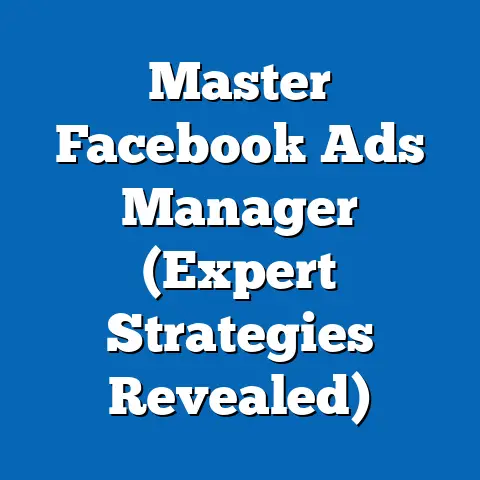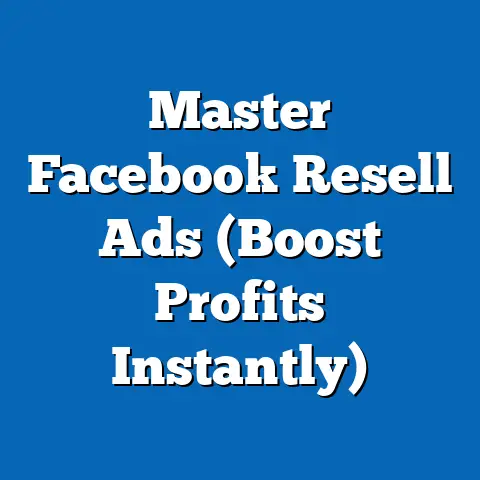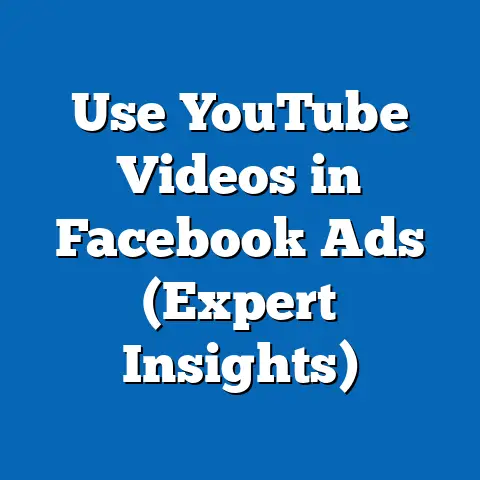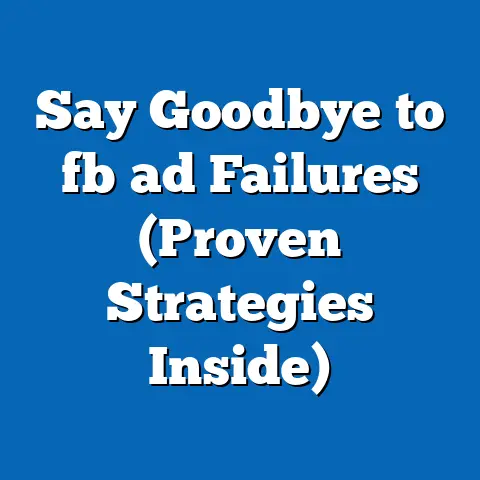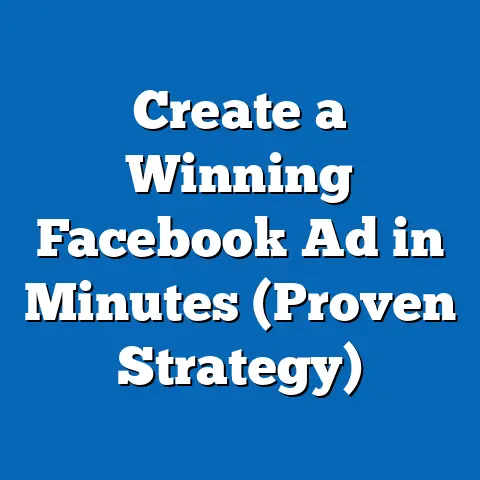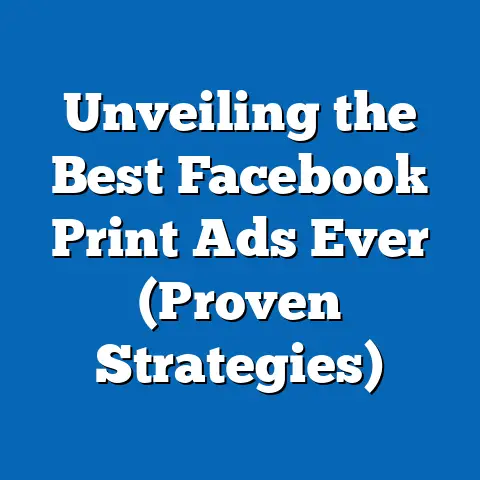Stop Facebook Ads: Unlock Ad Control Secrets (Pro Tips)
I’ve seen a shift happening in the digital marketing world, a quiet revolution led by trendsetters who are taking the reins of their advertising strategies. For years, Facebook Ads has been the go-to platform for many businesses, but savvy owners and marketers are realizing that relying solely on one platform isn’t just risky, it’s often less effective. They’re unlocking the secrets to ad control, moving away from complete dependence and embracing a more strategic, diversified approach.
Think of it like this: you wouldn’t put all your eggs in one basket, right? The same principle applies to advertising. This article isn’t about bashing Facebook Ads; it’s about empowering you to take control and build a sustainable advertising strategy that delivers real results. I’ll share pro tips gleaned from my own experiences and observations, helping you navigate the changing landscape and unlock the power of ad control.
Section 1: Understanding the Changing Landscape of Digital Advertising
The digital marketing landscape is in constant flux. What worked yesterday might not work today, and what works today might be obsolete tomorrow. Facebook Ads, once the undisputed king of social media advertising, is now facing increased competition and a more discerning audience.
The Current State of Facebook Ads
Over the past few years, I’ve witnessed significant shifts within the Facebook Ads ecosystem. We’ve seen policy changes related to data privacy, algorithm updates that impact ad delivery, and evolving user engagement trends. The introduction of iOS 14 privacy updates, for example, significantly impacted ad tracking and targeting capabilities, making it harder to measure campaign performance accurately.
Add to that the increasing saturation of ads on the platform. Users are bombarded with sponsored content, leading to ad fatigue and decreased engagement. This, in turn, drives up the cost of advertising, making it more challenging for small businesses and startups to compete with larger corporations.
Why Facebook Ads Might Be Losing Its Luster
Several factors contribute to the declining effectiveness of Facebook Ads for certain businesses. These include:
- Increased Competition: The platform is becoming increasingly crowded, driving up ad costs and making it harder to stand out.
- Algorithm Changes: Facebook’s algorithm is constantly evolving, which can significantly impact ad reach and performance.
- Data Privacy Concerns: Heightened awareness of data privacy issues has led to stricter regulations and limitations on ad targeting.
- Changing User Behavior: Users are spending more time on other platforms and engaging with different types of content, reducing the effectiveness of Facebook Ads.
I remember working with a client in the e-commerce space who saw their Facebook Ads ROI plummet after a major algorithm update. We had to completely overhaul their strategy, shifting focus to other platforms and experimenting with new ad formats to regain their previous performance levels.
Diversifying Beyond Facebook: The Key to Survival
The key takeaway here is that relying solely on Facebook Ads is no longer a viable long-term strategy. Marketers need to diversify their ad spend and explore alternative platforms to reach their target audience effectively. This means adapting to a rapidly evolving digital environment and being willing to experiment with new approaches.
Takeaway: The digital advertising landscape is constantly changing. Don’t put all your eggs in one basket. Diversify your ad strategies beyond Facebook to mitigate risk and reach a wider audience.
Section 2: The Importance of Ad Control
So, what does it really mean to have “ad control,” and why is it so vital in today’s competitive digital landscape?
Defining Ad Control: Taking the Reins
To me, ad control means having the ability to make informed decisions about your advertising spend, targeting, and performance metrics. It’s about owning your data, understanding your audience, and having the flexibility to adapt your strategies quickly based on real-time insights.
It’s not just about setting a budget and letting Facebook’s algorithm do its thing. It’s about actively managing your campaigns, testing different approaches, and optimizing your strategies to achieve the best possible results.
The Benefits of Owning Your Ad Strategy
Having control over your ad strategy offers numerous benefits:
- Reduced Ad Spend: By understanding your audience and optimizing your campaigns, you can reduce wasteful ad spend and improve your ROI.
- Improved Targeting: You can refine your targeting strategies to reach the most relevant audience, increasing the likelihood of conversions.
- Enhanced Performance Metrics: You can track and analyze key performance indicators (KPIs) to measure the effectiveness of your campaigns and make data-driven decisions.
- Increased Flexibility: You can quickly adapt your strategies to respond to changing market conditions and user behavior.
- Greater Independence: You’re not solely reliant on a single platform, giving you more control over your brand and messaging.
Real-World Examples: Brands Regaining Control
I’ve seen firsthand how brands have successfully regained control of their ad strategies and the positive impact it has had on their bottom line.
For example, a local restaurant I worked with was heavily reliant on Facebook Ads to drive traffic to their establishment. However, they were struggling to see a return on their investment. We helped them shift their focus to Google Ads, targeting local customers searching for specific types of cuisine. We also implemented a loyalty program and email marketing strategy to build a direct relationship with their customers. As a result, they saw a significant increase in foot traffic and revenue, all while reducing their reliance on Facebook Ads.
Takeaway: Ad control is about taking ownership of your advertising strategy, making informed decisions, and optimizing your campaigns for maximum impact. It offers numerous benefits, including reduced ad spend, improved targeting, and increased flexibility.
Section 3: Pro Tips for Unlocking Ad Control
Now, let’s dive into the practical steps you can take to unlock ad control and build a more sustainable advertising strategy.
Tip 1: Know Your Audience Inside and Out
This is the foundation of any successful advertising campaign. You need to understand your target audience intimately: their demographics, interests, behaviors, pain points, and motivations. The more you know about them, the better you can tailor your messaging and targeting to resonate with them.
- Gathering Data: Use a combination of methods to gather data on your target audience, including:
- Customer Surveys: Ask your existing customers about their preferences, needs, and experiences.
- Social Media Analytics: Analyze your social media data to gain insights into your audience’s demographics, interests, and engagement patterns.
- Website Analytics: Track user behavior on your website to understand how they interact with your content and products.
- Market Research: Conduct market research to identify broader trends and insights about your target market.
- Creating Customer Personas: Develop detailed customer personas that represent your ideal customers. These personas should include information about their demographics, interests, behaviors, goals, and challenges.
- Customer Surveys: Ask your existing customers about their preferences, needs, and experiences.
- Social Media Analytics: Analyze your social media data to gain insights into your audience’s demographics, interests, and engagement patterns.
- Website Analytics: Track user behavior on your website to understand how they interact with your content and products.
- Market Research: Conduct market research to identify broader trends and insights about your target market.
I once worked with a clothing retailer who was struggling to target their Facebook Ads effectively. By conducting thorough audience research, we discovered that their target audience was primarily interested in sustainable and ethically sourced clothing. We then tailored their ad messaging to highlight these values, resulting in a significant increase in ad engagement and conversions.
Tip 2: Leverage Alternative Ad Platforms
Don’t limit yourself to Facebook Ads. There are numerous other platforms that offer unique advertising opportunities, each with its own strengths and weaknesses.
- Google Ads: Reach customers actively searching for your products or services.
- TikTok: Target a younger audience with short-form video content.
- LinkedIn: Connect with professionals and businesses.
- Pinterest: Reach users interested in visual inspiration and DIY projects.
- Amazon Ads: Target customers actively shopping on Amazon.
Comparing Platforms:
| Platform | Targeting Options | Cost | User Engagement | Best Use Cases |
|---|---|---|---|---|
| Facebook Ads | Demographics, interests, behaviors, custom audiences | Varies based on competition and targeting | High, but can be affected by ad fatigue | Brand awareness, lead generation, e-commerce |
| Google Ads | Keywords, demographics, location | Varies based on keyword competition | High for relevant searches | Driving website traffic, generating leads, e-commerce |
| TikTok | Demographics, interests, behaviors, custom audiences | Generally lower than Facebook Ads | Very high, especially for engaging content | Reaching a younger audience, brand awareness, viral marketing |
| Job title, industry, company size, skills | Generally higher than other platforms | High for professional content and networking | B2B marketing, lead generation, recruitment | |
| Interests, keywords, demographics | Varies based on competition and targeting | High for visual inspiration and product discovery | Driving website traffic, generating leads, e-commerce, promoting visual content |
| Platform | Targeting Options | Cost | User Engagement | Best Use Cases |
|---|---|---|---|---|
| Facebook Ads | Demographics, interests, behaviors, custom audiences | Varies based on competition and targeting | High, but can be affected by ad fatigue | Brand awareness, lead generation, e-commerce |
| Google Ads | Keywords, demographics, location | Varies based on keyword competition | High for relevant searches | Driving website traffic, generating leads, e-commerce |
| TikTok | Demographics, interests, behaviors, custom audiences | Generally lower than Facebook Ads | Very high, especially for engaging content | Reaching a younger audience, brand awareness, viral marketing |
| Job title, industry, company size, skills | Generally higher than other platforms | High for professional content and networking | B2B marketing, lead generation, recruitment | |
| Interests, keywords, demographics | Varies based on competition and targeting | High for visual inspiration and product discovery | Driving website traffic, generating leads, e-commerce, promoting visual content |
Tip 3: Utilize Retargeting Strategies
Retargeting is a powerful technique that allows you to reach customers who have previously interacted with your brand. It’s like giving them a gentle nudge to remind them of your products or services.
- Setting Up Retargeting Campaigns:
- Website Retargeting: Target users who have visited your website but haven’t made a purchase.
- Email Retargeting: Target users who have opened your emails but haven’t clicked on a link.
- Social Media Retargeting: Target users who have interacted with your social media content.
- Website Retargeting: Target users who have visited your website but haven’t made a purchase.
- Email Retargeting: Target users who have opened your emails but haven’t clicked on a link.
- Social Media Retargeting: Target users who have interacted with your social media content.
I remember working with an online course provider who significantly increased their conversion rates by implementing a retargeting campaign. They targeted users who had visited their course pages but hadn’t enrolled, reminding them of the benefits of the course and offering a limited-time discount.
Tip 4: Invest in Quality Content That Resonates
High-quality content is the cornerstone of any successful advertising campaign. It’s what captures your audience’s attention, builds trust, and ultimately drives conversions.
- Engaging Visuals: Use high-quality images and videos that are visually appealing and relevant to your brand.
- Compelling Copy: Write clear, concise, and persuasive copy that highlights the benefits of your products or services.
- Storytelling: Craft compelling stories that resonate with your audience and create an emotional connection.
I always tell my clients, “Don’t just sell a product; sell a story.” People are more likely to remember and engage with content that tells a story and evokes emotions.
Tip 5: Monitor and Analyze Performance Relentlessly
Regular ad performance analysis is crucial for understanding what’s working and what’s not. Use the data you collect to optimize your campaigns and make data-driven decisions.
-
Key Metrics: Track the following key metrics to assess the effectiveness of your campaigns:
- Click-Through Rate (CTR): The percentage of users who click on your ad.
- Conversion Rate: The percentage of users who complete a desired action (e.g., make a purchase, sign up for a newsletter).
- Cost Per Acquisition (CPA): The cost of acquiring a new customer.
- Return on Ad Spend (ROAS): The revenue generated for every dollar spent on advertising.
-
Tools: Use the following tools to monitor and analyze your ad performance:
- Google Analytics: Track website traffic and user behavior.
- Facebook Ads Manager: Monitor and analyze your Facebook Ads campaigns.
- Third-Party Analytics Tools: Explore other analytics tools that offer advanced features and insights.
Key Metrics: Track the following key metrics to assess the effectiveness of your campaigns:
- Click-Through Rate (CTR): The percentage of users who click on your ad.
- Conversion Rate: The percentage of users who complete a desired action (e.g., make a purchase, sign up for a newsletter).
- Cost Per Acquisition (CPA): The cost of acquiring a new customer.
- Return on Ad Spend (ROAS): The revenue generated for every dollar spent on advertising.
Tools: Use the following tools to monitor and analyze your ad performance:
- Google Analytics: Track website traffic and user behavior.
- Facebook Ads Manager: Monitor and analyze your Facebook Ads campaigns.
- Third-Party Analytics Tools: Explore other analytics tools that offer advanced features and insights.
Takeaway: Unlocking ad control requires a multi-faceted approach that includes knowing your audience, leveraging alternative platforms, utilizing retargeting strategies, investing in quality content, and monitoring performance.
Section 4: Building a Sustainable Advertising Strategy
Building a sustainable advertising strategy is not a one-time task; it’s an ongoing process of adaptation and optimization.
Creating a Long-Term Vision
Develop a long-term vision for your advertising strategy that aligns with your overall business goals. This vision should incorporate the principles of ad control, diversification, and data-driven decision-making.
Continuous Adaptation and Evolution
The digital landscape is constantly evolving, so your advertising strategies must evolve with it. Continuously monitor your performance data, stay up-to-date on industry trends, and be willing to experiment with new approaches.
Budgeting and Resource Allocation
Allocate your budget and resources strategically across different platforms and channels. Don’t put all your eggs in one basket. Diversify your ad spend to mitigate risk and maximize your reach.
Measuring Long-Term Success
Focus on measuring long-term success metrics, such as brand awareness, customer loyalty, and lifetime customer value. These metrics provide a more holistic view of your advertising performance and help you make better decisions about your future investments.
Takeaway: Building a sustainable advertising strategy requires a long-term vision, continuous adaptation, strategic budgeting, and a focus on long-term success metrics.
Conclusion:
While Facebook Ads can still be a valuable tool in your advertising arsenal, it’s crucial to understand that it’s not the only game in town. By embracing the ad control secrets I’ve shared, you can unlock the power of diversification, take ownership of your advertising strategy, and drive better results.
Don’t be afraid to experiment with new platforms, test different approaches, and continuously optimize your campaigns based on data. The future of digital advertising lies in innovation, adaptability, and a willingness to take control of your own destiny.
So, go forth and conquer the digital landscape! Take control of your advertising, diversify your strategies, and unlock the full potential of your marketing efforts. The results, I promise, will speak for themselves.

